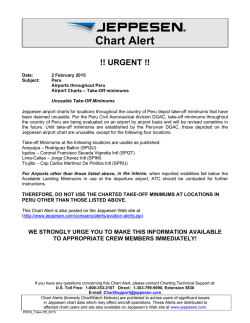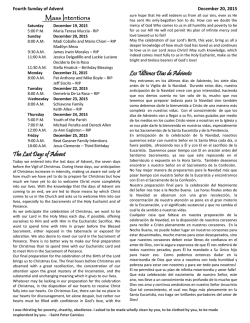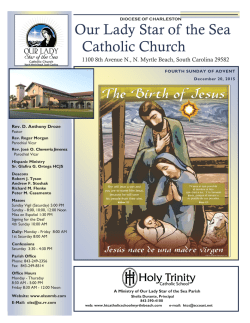
Problemas de datación de la Formación Navidad y possibles
UNIVER SIDAD DE CONCEPCIÓN DEPARTAMENTO DE CIENCIAS DE LA TIERRA 10° CONGRESO GEOLÓGICO CHILENO 2003 TOWARDS AN UNDERSTANDING OF THE AGE OF THE NAVIDAD FORMATION NIELSEN, S. N. . 1, DeVRIES, T. J. . 2, ENCINAS, A. . 3, FINGER, K. L. . 4, PETERSON, D. . 5 1 Geologisch-Paläontologisches Institut und Museum, Universität Hamburg, Bundesstrasse 55, 20146 Hamburg, Germany. [email protected] 2 Burke Museum of Natural History and Culture, University of Washington, Seattle, WA 98195 USA (Mailing address: Box 13061, Burton, WA 98013 USA). [email protected] 3 Universidad de Chile, Departamento de Geología, Casilla 13518, Correo 21, Santiago, Chile. [email protected] 4 University of California Museum of Paleontology, 1101 Valley Life Sciences Building, Berkeley, CA 94720-4780 USA. [email protected] 5 California Academy of Sciences, Dept. of Invertebrate Zoology and Geology, Golden Gate Park, San Francisco, California 94118-4599 USA. [email protected] INTRODUCTION Ages of the Navidad Formation presented in the literature differ markedly from each other. The first micropaleontological data came from Martínez and Osorio (1968), who dated the Navidad Formation as Tortonian based on foraminifera and discoasters. Dremel (in Herm 1969) reported Burdigalian foraminifera from the coast at Punta Perro. This coastal locality is part of the basal member of the Navidad Formation in the scheme of Tavera (1979). Using the model of Tavera (1979) in the modified version of Martínez-Pardo (1990) and Valenzuela (1990), sedimentation of the Navidad Formation began during the upper Burdigalian (planktic foraminiferal zone N5/6, 19 Ma) and persisted until the lowermost Tortonian (N15, 10 Ma). Encinas and Suárez (2002) reported the presence of Carcharoides totuserratus, an elasmobranch from the late Oligoceneearly Miocene, in the basal member of Navidad Formation. Meón et al. (1994), studying pollen in the same levels used by many of the authors that studied foraminifers and ostracodes, dated the basal member of the Navidad Formation as late early Miocene-late Miocene. In contrast, Martínez and Osorio (1968) and Ibaraki (1992a) dated the basal unit at Punta Perro as Tortonian (N16/17, 10-5 Ma). Based on the evidence of younger ages, the Miocene deposits of central Chile would represent a relatively brief interval rather than almost the entire Miocene. For this study, we investigated the coastal outcrops of the Navidad Formation (Figure 1), including most localities of previous workers. We measured sections, described sedimentary features, and collected samples for macro- and microfossils. All of these outcrops are referred to to the Navidad Member, which is the basal member of the Navidad Formation (Tavera 1979). Outcrops farther inland are heavily weathered and our samples from them were devoid of fossils. For comparison with the Navidad Member, we also examined material from the Ranquil Formation at Peninsula Arauco, and the Lacui Formation at Chiloé Island (Figure 1). Todas las contribuciones fueron proporcionados directamente por los autores y su contenido es de su exclusiva responsabilidad. Figure 1. Sampled localities of the Navidad Formation and comparable units. SEDIMENTOLOGY The lower member of the Navidad Formation has a fossiliferous marine conglomerate at its base that marks the beginning of a relative rise in sea level. The succession continues with mudstone, siltstone, sandstone and conglomerate beds with sedimentary features such as massive sandstones with water-escape structures, sheared mud flames and basal rip-up mudclasts, Bouma sequences, sedimentary breccia beds, slumps and slides. These features reveal that the Navidad Member was formed by gravity-driven flows (e.g., sandy debris flows, turbidity currents, debris flows, slides and slumps) alternating with hemipelagic deposits (Encinas et al. in press, this volume). PALEONTOLOGY Planktic foraminiferal assemblages in many of our samples reveal a Tortonian age (N16) for the Navidad Member (Finger et al. this volume). Mixed depth associations in the Navidad, Ranquil, and Lacui Formations (Encinas et al. in press; Finger et al. this volume) indicate displacement of sediments into bathyal depths greater than 1500 meters (Finger et al. this volume). Some Cretaceous and early and middle Miocene foraminifera in these deposits also reveal reworking of older deposits. Comparison of molluscan assemblages in the Navidad Formation with those of southern Peru favors a youngest Oligocene to early middle Miocene age for the Navidad molluscan fauna (DeVries and Frassinetti 2003; DeVries and Nielsen this volume). Several distinctive Navidad species occur in forearc basins of southern Peru, including Ficus distans Sowerby, 1846, Acanthina katzi (Fleming, 1972), Testallium cepa (Sowerby, 1846), Olivancellaria tumorifera (Hupé, 1854), and Glycymeris ibariformis Frassinetti and Covacevich, 1984 (DeVries 1997a and in press; DeVries and Vermeij 1997; Vermeij and DeVries 1997). The Peruvian specimens of these species were found in sediments that have been dated using radiolaria (Marty 1989), foraminifera (Dunbar et al. 1990; Ibaraki 1992a, 1992b, and 1993), diatoms (Macharé and Fourtanier 1987; Macharé et al. 1988; Dunbar et al. 1990; DeVries 1998; H. Schrader, unpublished data), 40K-40Ar isotopes (Muizon and Bellon 1980 and 1985; Noble et al. 1985; Muizon and DeVries 1985; Dunbar et al. 1990), and 40Ar-39Ar isotopes (DeVries 1998; DeVries, unpublished data). Upper Miocene (Tortonian, Messinian) and Pliocene sediments from southern Peru contain many molluscan species that are the same as those found in Chilean deposits traditionally assigned to post-Navidad, upper Miocene and Pliocene depositional units (Herm 1969; DeVries and Frassinetti 2003; Guzmán et al. 2000). Middle Miocene (Serravallian) deposits in Peru contain a distinctive suite of molluscan species, some being the same as middle Miocene species from the Talara Basin of northern Peru (DeVries 1997b), but none occurring in the Navidad Formation. The youngest specimens of 'Navidad' species appear in southern Peru in basal deposits of the Pisco Formation (Langhian), but they are most common throughout the lower Miocene (Burdigalian, Aquitanian) deposits of the Chilcatay Formation (DeVries 1998). The oldest occurrences of Navidad species (Olivancellaria tumorifera, Testallium cepa) are found in uppermost Oligocene (Chattian) deposits near Caravelí and Nazca (DeVries 2000). The Caravelí fossils are in beds correlative with volcanic ashes dated at about 25 Ma (Noble et al. 1985). The lower Miocene sediments of southern Peru were deposited in a variety of marine environments, ranging from intertidal to upper slope. The intertidal deposits include oysterencrusted boulders of igneous rock and a diverse transported assemblage of mollusks, shark teeth, and other vertebrate remains. In contrast, the deeper water deposits are tuffaceous, diatomaceous silty fine-grained sandstones bearing cetacean bones, sardine and anchovy vertebrae and scales, and scattered articulated venerid bivalves (DeVries and Nielsen this volume). Accumulations of 'Navidad' mollusks are typically found where sedimentary structures and textures suggest intertidal to inner neritic environments. IN SITU OR MIXED FAUNAS? The different sampled localities from Chile (Figure 1) can be divided among three environmental settings based on their sedimentological and paleontological data (Table 1). We interpret these as representing original settings prior to subsequent displacement. Assigning 83 gastropod genera to these environments (Figure 2) results in a distribution pattern that suggests the sediment Figure 2. Percentage distribution of gastropod genera in different depositional environments. Table 1. Division of localities among environmental settings. Int: Intertidal, Sw: shallow water, Dw: deep water. X X X X CHO CUC PCT X RQT X X LACUI FM RQS RQK X RAN X X X LEB X FRM FRA PUY PTA PPT PPS X PPP X PPN PPG X RANQUIL FM RAP X MAT Int Sw D w MAP LBZ NAVIDAD FM X X X X X packages only contain unmixed assemblages rather than mixed associations resulting from reworking and displacement. Occurrence in two or all three environments is mainly due to the very rough divisions or, for some genera (e.g., Terebra, Turritella), the presence of more than one species. Among the representative gastropods of the intertidal zone are new species of Fissurella, Pilosabia, and Zonaria. Shallow-water associations contain the majority of classic Navidad mollusk taxa such as ‘Trochus laevis’, Sassia armata, Lamprodomina dimidiata, and Olivancillaria tumorifera. Much less common in the Navidad are deep-water taxa, including articulated brittle stars of the genus Ophiomusium (Kutscher et al. this volume) and the gastropods Struthiochenopus philippii, Falsilunatia, Dalium, Exilia, and Borsonia. The small group of gastropods represented in all three environments consists of Sinum subglobosum, Echinophoria, Testallium cepa, and Ptychosyrinx. Some of the relatively large mollusks are fragile (e.g. Xenophora, Nielsen and DeVries 2002) and their preservation suggests that, if they were transported downslope, it would have involved relatively nonchaotic displacement (e.g., slumping) of a large sedimentary package. CONCLUSIONS (1) Planktic foraminifera indicate that the Navidad Formation was deposited during the lower part of planktic foraminiferal Zone N16 (about 10 to 11 Ma), which correlates with the Tortonian interval of the Late Miocene. (2) Reworking and mixing of older sediments into the Navidad Formation is evidenced by the inclusion of some Cretaceous and Early Miocene foraminifera in the Late Miocene assemblages. (3) Downslope transport of sediments is evidenced by the mixed-depth microfaunal associations and some sedimentary features. Whereas slumping and sliding is recognized in less than 5% of the sedimentary facies, we cannot account for displacement of large sediment-packages in most of our studied localities. (4) Although there may have been outcrops of earlier Miocene sediments that contributed reworked foraminifera and mollusks to the deposits of the Navidad during the Late Miocene, there are no modern exposures of this source rock known in the region. (5) Some mollusks are the same as species from well-dated southern Peruvian strata of youngest Oligocene to early middle Miocene age (DeVries & Frassinetti 2003). (6) Gastropods appear to be in original associations rather than mixed-depth assemblages, and they show no evidence of reworking. Considering all of the above statements, a logical conclusion would be that there was redeposition of Early to Middle Miocene sediments during the Late Miocene. However, this reinterpretation also revives questions previously thought to have been resolved: (1) Whereas the Navidad Formation is unconformably superjacent to Cretaceous and Eocene strata (e.g., at Topocalma just south of the main Navidad region [Tavera 1979; Encinas and Nielsen unpublished data]) no lower to middle Miocene deposits are known that could have been a source for the other reworked microfossils. Lower to middle Miocene deposits may certainly be present below the Navidad Formation somewhere but this can only be resolved with seismic and/or borehole data. However, such data do not exist or are at least currently not available to us. (2) The hypothesis that some mollusks date from the Early to Middle Miocene and have been redeposited together with foraminifera of the same age during the Late Miocene can presently neither be proven nor refuted. Such a scenario, however, needs careful documentation if it has to be applied for most Miocene formations between Navidad and Chiloé (i.e. at least the Navidad, Ranquil, and Lacui formations). (3) If mollusk associations are redeposited within larger sediment packages conserving their original sedimentological features, it will be a major task to separate lower Miocene associations from upper Miocene ones and assign faunal dissimilarities to either diachronism or bathyal differences. Should they, on the other hand, be displaced but contemporaneous with Late Miocene foraminifera, documentation of and explanations for the southward shifting of geographic ranges of several identical species from Peru to Chile, resulting in diachronous occurrences seperated by about 10 Ma, must be found. ACKNOWLEDGMENTS The work of S. Nielsen has been supported by the University of Hamburg and the Deutsche Forschungsgemeinschaft (DFG) grant Ba 675/25. Special thanks go to K. Bandel (University of Hamburg) for a great time during field-work and numerous discussions. A. Encinas was supported by Proyecto Fondecyt 1010691, Programa MECE Educación Superior UCH0010, Beca PG/50/02 of the Departamento de Postgrado y Postítulo-Universidad de Chile. REFERENCES DeVries, T. J. 1997a. Neogene Ficus (Mesogastropoda: Ficidae) from the Pisco Basin (Peru). Boletín de la Sociedad Geológica del Perú. Vol. 86. p. 11-18. DeVries, T. J. 1997b. Middle Miocene marine sediments in the Pisco Basin (Peru). Boletín de la Sociedad Geológica del Perú. Vol. 87. p. 1-13. DeVries, T. J. 1998. Oligocene deposition and Cenozoic sequence boundaries in the Pisco Basin (Peru). Journal of South American Earth Sciences. Vol. 11. p. 217-231. DeVries, T. J. 2000. Molluscan evidence for an Oligocene-Miocene age of 'Paracas' beds in southern Peru. Boletín de la Sociedad Geológica del Perú. Vol. 92. p. 57-65. DeVries, T. J. (in press) Acanthina Fischer von Waldheim, 1807 (Gastropoda: Muricidae), an ocenebrine genus endemic to South America. The Veliger. DeVries, T. J. and Frassinetti C, D. 2003. Range extensions and biogeographic implications of Chilean Neogene mollusks found in Peru. Boletín del Museo Nacional de Historia Natural, Chile. Vol. 52. p. 141-157. DeVries, T. J. and Nielsen, S. N. 2003. “Navidad“ Mollusks in Peru: Paleoenvironmental Implications for the Interpretation of Depositional Settings in Chile. 10° Congreso Geológico Chileno. 2003. Concepción. Chile. DeVries, T. J. and Vermeij, G. J. 1997. Herminespina: New genus of Neogene muricid gastropod from Peru and Chile. Journal of Paleontology. Vol. 71. p. 610-615. Dunbar, R. B., Marty, R. C. and Baker, P. A. 1990. Cenozoic marine sedimentation in the Sechura and Pisco basins, Peru. Palaeogeography, Palaeoclimatology, Palaeoecology. Vol. 77. p. 235-261. Encinas, A. and Suárez, M. 2002. Fauna fósil de Elasmobranquios del Mioceno Temprano de la Formación Navidad, Chile Central. Correlación con la fauna fósil Argentina. VIII Congreso Argentino de Paleontología y Bioestratigrafía. Corrientes. Argentina. p. 99 Encinas, A., Le Roux, J., Finger, K., Peterson, K., Suárez, M. and Nielsen, S. in press. Age and Deposition of the Lower Navidad Formation in Central Chile. 3rd Latin American Congress of Sedimentology. Encinas, A., Finger, K. , Nielsen, S., Suárez, M., Peterson, D. and Le Roux, J. 2003. Evolución tectono-sedimentaria de la Cuenca Neógena de Navidad (33°40’S-34°15’S), Chile central. 10° Congreso Geológico Chileno. 2003. Concepción Chile. Finger, K., Peterson, D., Encinas, A. and Nielsen, S. 2003. Microfaunal indications of late Miocene deep-water basins off the central coast of Chile. 10° Congreso Geológico Chileno. 2003. Concepción. Chile. Guzmán, N., Marquardt, C., Ortlieb, L. and Frassinetti, D. 2000. La malacofauna Neógena y Cuaternaria del área de Caldera (27º-28º S): Especies y rangos bioestratigráficos. IX Congreso Geológico Chileno, Actas. Vol. 1. p. 476481. Herm, D. 1969. Marines Pliozän und Pleistozän in Nord- und Mittel-Chile unter besonderer Berücksichtigung der Entwicklung der Mollusken-Faunen. Zitteliana. Vol. 2. p. 1-159. Ibaraki, M. 1992a. Neogene planktonic foraminiferal biostratigraphy on the coast of Peru and its paleoceanographic implications. In Pacific Neogene: environment, evolution, and events. Tsuchi R. and Ingle, Jr, J.C. (Eds.). University of Tokyo, Tokyo. p. 71-81. Ibaraki, M. 1992b. Neogene planktonic foraminifera of the Camaná Formation, Peru: Their geologic age and paleoceanographic implications. Reports of Andean Studies, Shizuoka University. Special Vol. 4. p. 9-19. Ibaraki, M. 1993. Eocene to early Miocene planktonic foraminifera from the south of Paracas, central Peru. Reports of the Faculty of Science, Shizuoka University. Vol. 27. p. 77-93. Kutscher, M., Neumann, C., Nielsen, S. N., Reich, M. and Villier, L. 2003. Equinodermos del Mioceno chileno entre Santiago y Chiloé. 10° Congreso Geológico Chileno. 2003. Concepción. Chile. Macharé, J., DeVries, T., Barron, J. and Fourtanier, E. 1988. Oligo-Miocene transgression along the Pacific margin of South America: new paleontological and geological evidence from the Pisco basin (Peru). Géodynamique. Vol. 3. p. 25-37. Macharé, J. and Fourtanier, E. 1987. Datation des formations tertiares du bassin de Pisco (Pérou) à partir d'asociations de diatomées. Comptes Rendus, Academie des Sciences (Paris) ser. II. Vol. 305. p. 407-412. Martínez-Pardo, R. 1990. Major Neogene events of the Southeastern Pacific: the Chilean and Peruvian record. Palaeogeography, Palaeoclimatology, Palaeoecology. Vol. 77. p. 263-278. Martínez, R. and Osorio, R., 1964. Discoastéridos y Foraminíferos de la Formación Navidad: nuevos antecedentes para su datación. Revista geológica de Chile. Vol. 9. p. 5-6. Marty, R. C. 1989. Stratigraphy and chemical sedimentology of Cenozoic biogenic sediments from the Pisco and Sechura basins, Peru. Unpublished Ph.D. dissertation. Rice University. Houston, Texas, USA. 268 pp. Meón, H., Torres, T., and Martínez-Pardo, R. 1994. Sporopollinic analysis in the Navidad Formation near Navidad (Chile). 7º Congreso Geológico Chileno, p. 488-490. Muizon, C. de and Bellon, H. 1980. L'âge mio-pliocène de la formation Pisco, Perou. Comptes Rendus, Academie des Sciences (Paris) ser. D. Vol. 290. p. 1063-1066. Muizon, C. de and Bellon, H. 1986. Nouvelles données su l'âge de la formation Pisco, Pérou. Comptes Rendus, Academie des Sciences (Paris) ser. D. Vol. 303. p. 1401-1404. Muizon, C. de and DeVries, T. J. 1985. Geology and paleontology of the Pisco Formation in the area of Sacaco, Peru. Geologische Rundschau. Vol. 74. p. 547-563. Nielsen, S. N. 2003. Zonación de gastrópodos en la Formación Navidad. 10° Congreso Geológico Chileno. 2003. Concepción. Chile. Nielsen, S. N. and DeVries, T. J. 2002. Tertiary Xenophoridae (Gastropoda) of western South America. The Nautilus. Vol. 116. p. 71-78. Noble, D., Sebrier, M., Megard, F. and McKee, E. 1985. Demonstration of two pulses of Paleogene deformation in the Andes of Peru. Earth and Planetary Science Letters. Vol. 73. p. 345-349. Tavera, J. 1979. Estratigrafía y paleontología de la Formación Navidad, Provincia de Colchagua, Chile (Lat. 30°50’34°S). Boletín del Museo Nacional de Historia Natural, Chile. Vol. 36. p. 1-176. Valenzuela A., E. 1990. Numerical ages of Miocene unconformities along Central Chile Coastal Zone. Segundo Simposio sobre el Terciario de Chile, Actas. p. 325-332. Vermeij, G. J. and DeVries, T. J. 1997. Taxonomic remarks on Cenozoic pseudolivid gastropods from South America. The Veliger. Vol. 40. p. 23-28.
© Copyright 2025



